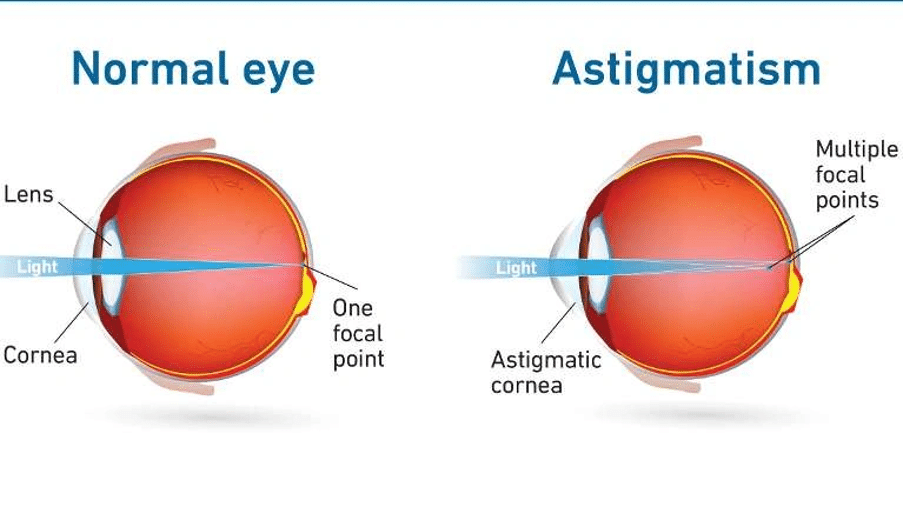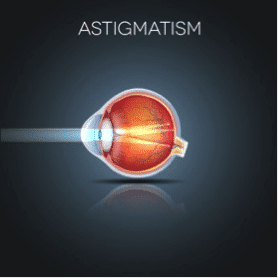About 70% of all glasses wearers have astigmatism. This vision defect affects many people in the UK and causes difficulties with both near and far vision. Blurry vision, headaches, or seeing round objects as oval shapes might indicate you have astigmatism.
Astigmatism affects most people to some degree. It’s a refractive error of the eye, not a disease. The condition causes blurry vision at all distances, making objects appear with fuzzy edges. You can check your vision easily at home. Online eye tests offer a simple evaluation of your eyesight to determine if you have astigmatism. These tests work best for healthy adults between 18-39 who have a mild prescription for eyeglasses.
This piece explores astigmatism’s nature, its signs, and ways to test yourself at home. You’ll also learn about advanced treatment options, from specialised contact lenses to innovative surgical procedures like laser eye surgery and lens replacement surgery.

What is astigmatism and how does it affect your vision?
Astigmatism happens because your eye’s shape resembles a rugby ball instead of a football. This causes light to focus at multiple points in the eye. The condition affects approximately 1 in 3 people worldwide. It ranks as one of the most common vision conditions in the UK.
Understanding the shape of the cornea
A normal eye’s cornea (the clear front surface) and lens have a spherical shape similar to a basketball. The even curvature helps focus light rays onto the retina at the back of your eye. An astigmatic eye’s cornea or lens has mismatched curves that create an egg-shaped or oval appearance. Light entering your eye cannot join at a single focal point because of this irregular shape. This creates two different refracting powers of light within the eye. Many people with astigmatism experience blurred or distorted vision as a result.
How light is refracted in astigmatic eyes
Light passing through a normal eye refracts and focuses on the retina. The irregular shape of an astigmatic eye prevents proper focus of light rays. The astigmatic eye creates focal lines instead of one clear image. These focal lines can appear in front of the retina, behind it, or both—based on the type of astigmatism. Objects appear blurry at all distances because of this imperfect focusing.

Types of astigmatism: myopic and hypermetropic
Astigmatism usually occurs among other refractive errors. Light focuses in front of the retina in myopic astigmatism. Two subtypes exist: simple myopic astigmatism (one focal point on the retina, one in front) and compound myopic astigmatism (both focal points in front of the retina).
Light focuses behind the retina in hypermetropic astigmatism. It also has two variations: simple hypermetropic astigmatism (one focal point on the retina, one behind) and compound hypermetropic astigmatism (both focal points behind the retina). A mixed type also exists where one meridian shows myopia and another shows hypermetropia. This creates a complex visual experience for affected people.
How to know if you have astigmatism: signs to watch for
Early detection of astigmatism symptoms helps you get proper treatment before your vision gets worse. An astigmatism eye test from an eye care professional confirms the diagnosis, but several signs might show you have this common condition.
Blurry or distorted vision at all distances
Blurry or distorted vision that affects both near and far objects stands as astigmatism’s most common symptom. Unlike other vision issues that might affect specific distances, astigmatism usually causes blur everywhere. Printed words might look fuzzy, and road signs could appear distorted. The blurriness tends to be stronger in one specific direction—horizontally, vertically, or diagonally.
Frequent headaches or eye strain
Persistent headaches often come with untreated astigmatism. Your eye muscles keep contracting as they try to focus properly. These headaches usually show up after you spend time reading or working on computers. Eye fatigue comes along with these headaches, especially during long visual tasks.

Difficulty seeing at night
People with astigmatism struggle the most with night vision. Your pupil gets bigger in low light to let more light in, but this lets more peripheral light rays enter too, which makes the blurring worse. Light sources might have halos or streaks around them, and oncoming car headlights could show “lines” of light spreading outward. Night driving becomes quite challenging.
Squinting or watery eyes
People naturally squint when they can’t see clearly. Those with astigmatism often squint without realising it as they try to sharpen their vision. So if you catch yourself squinting often to see better, astigmatism might be the reason. This constant effort strains your eyes and can make them water.
Double vision or ghosting
“Ghosting” or a type of double vision marks a unique symptom of astigmatism. Light focuses on multiple points in your eye instead of just one. The ghost image appears with each eye alone and both eyes open, which points to an issue in your eye’s focusing parts (cornea and lens). This matches what happens with astigmatism.
Take this simple online test for astigmatism
You can do a simple at-home test to check for astigmatism while waiting for your eye doctor appointment. These tests help you learn about your vision health but should not replace a professional examination.
How the dial test works
The dial test (sometimes called an astigmatic dial or sunburst chart) uses a basic principle. It shows lines arranged radially like rays of sunshine or a clock face. The cornea’s irregular shape in astigmatic eyes makes light focus differently in various directions. Some lines on the test look darker, blurrier, or more distinct than others. This happens because your eyes refract light differently based on direction.

Step-by-step instructions for testing at home
- Sit approximately 35-40 cm (about arm’s length) from your screen with the dial test.
- Take the test with and without glasses if you wear them.
- Cover one eye completely with your hand but don’t press on it.
- Look at the dial’s centre with your uncovered eye.
- Check if any lines look darker, clearer, or more distinct.
- Do the same test with your other eye.
This simple test might indicate astigmatism if lines appear blurry or distorted.
What your results might indicate
People with astigmatism usually see some lines sharper or darker than others on the dial. Clearer horizontal lines might show “against-the-rule” astigmatism, while clearer vertical lines could mean “with-the-rule” astigmatism. Your prescription might need updating if you notice differences in line clarity even with your current glasses.
When to seek professional diagnosis
At-home tests have most important limitations. These tests only suggest possible astigmatism—they can’t determine its severity or exact prescription needed. You should see an eye doctor if you have:
- Blurry vision at any distance
- Frequent headaches after visual tasks
- Eye strain or fatigue
- Difficulty seeing at night
- Double vision in either eye
Note that only a complete eye examination by a qualified professional can give you an accurate diagnosis and proper correction options.
Treatment options available at Precision Vision London
After an astigmatism diagnosis, clear vision depends on choosing the right treatment. Precision Vision London provides several solutions that match your specific needs.
Advanced laser eye surgery options
Precision Vision London provides state-of-the-art laser treatments including LASIK and LASEK for permanent correction. These procedures reshape the cornea to improve light focus on the retina. Dr CT Pillai performs all laser surgeries. He stands among the UK’s leading refractive surgeons with over 30 years of experience.
Lens replacement surgery for long-term correction
This procedure works best if you have presbyopia alongside astigmatism and are over 45. It replaces your natural lens with an artificial intraocular lens. Doctors commonly implant trifocal lenses that provide clear vision at multiple distances.
ICL surgery for high prescriptions
Implantable Contact Lenses (EVO ICLs) work exceptionally well if your prescription is too high for laser surgery or you have thin corneas. Surgeons place these lenses behind the iris to focus light properly onto the retina.
Why choose Precision Vision London for your care
Precision Vision London’s independent vision correction clinic creates truly personalised treatment plans for each eye. Their steadfast dedication to patient care stands out—Medical Director Dr Pillai personally meets all patients and answers questions before surgery.
Precision Vision London’s expert team provides detailed diagnostic scans and personalised treatment for laser correction or Lens Replacement. Book your in-clinic evaluation today at our Harley Street location.
Conclusion
Millions of people in the UK have astigmatism, but many don’t realise they have this condition until the symptoms start bothering them. The simple at-home test we described earlier might give you a first glimpse, but you’ll need a professional diagnosis to get the full picture. Your vision needs expert care, especially when you have persistent blurriness, headaches, or trouble seeing at night.
Precision Vision London creates solutions that match your specific visual needs. Our non-surgical options give immediate relief to many patients through prescription glasses with toric lenses and specialised contact lenses for daily wear. On top of that, if you want permanent correction, you can benefit from advanced treatments like LASIK, LASEK, lens replacement surgery, or ICL procedures. Our Medical Director, Dr CT Pillai, performs all these procedures with unmatched expertise.
Note that astigmatism is different for everyone, which is why each person needs their own treatment plan. At our Harley Street clinic’s consultation, you’ll get detailed diagnostic scans and expert guidance about the best correction method for your eyes.
Here’s the bright side – astigmatism responds well to treatment. The right diagnosis and proper care can improve your vision by a lot and reduce your symptoms. You might have dealt with blurry vision for years, or noticed changes in your eyesight recently. Taking action now could revolutionise how you see the world every day.
Schedule your detailed eye evaluation today and start your journey toward better, more comfortable vision. After all, everything looks better when you can see it clearly.
Key Takeaways
Understanding astigmatism and recognising its symptoms early can help you seek appropriate treatment before your vision deteriorates further.
- Astigmatism affects 70% of glasses wearers, causing blurry vision at all distances due to irregular cornea shape • Key symptoms include persistent headaches, eye strain, difficulty with night vision, and frequent squinting • Simple at-home dial tests can indicate astigmatism, but professional diagnosis remains essential for accuracy • Treatment options range from toric lenses and specialised contacts to advanced laser surgery and lens replacement • Early detection and proper treatment can significantly improve daily visual comfort and quality of life
Whilst online tests provide useful initial screening, only comprehensive professional examination can determine the exact type and severity of astigmatism you may have, ensuring you receive the most appropriate correction for your specific needs.
FAQs
Q1. How is astigmatism diagnosed? Astigmatism is typically diagnosed through a comprehensive eye examination. An optometrist or ophthalmologist will perform various tests, including a refraction test to determine how your eyes bend light. They may also use specialised instruments and ask you to look through different lenses to assess your vision accurately.
Q2. Can I have astigmatism even with 20/20 vision? Yes, it’s possible to have 20/20 vision and still have astigmatism. Astigmatism can cause intermittent blurry vision at all distances, unlike other vision conditions that affect specific ranges. Even with generally clear vision, you might experience periods of distortion or blurriness due to astigmatism.
Q3. What are the common symptoms of astigmatism? Common symptoms of astigmatism include blurry or distorted vision at all distances, frequent headaches, eye strain, difficulty seeing at night, and squinting or watery eyes. You might also experience ‘ghosting’ or a type of double vision in more severe cases.
Q4. Can astigmatism be corrected without surgery? Yes, astigmatism can often be corrected without surgery. Non-surgical options include prescription glasses with toric lenses and specialised contact lenses designed for astigmatism. These solutions can effectively redirect light onto the retina, correcting the visual distortion caused by astigmatism.
Q5. What advanced treatment options are available for astigmatism? Advanced treatment options for astigmatism include laser eye surgery (such as LASIK and LASEK), lens replacement surgery, and implantable contact lens (ICL) surgery. These procedures can provide long-term or permanent correction for astigmatism, especially for those with higher prescriptions or when combined with other vision issues.
Authors & Reviewer
-
 Olivia: Author
Olivia: AuthorHi, I'm Olivia, a passionate writer specialising in eye care, vision health, and the latest advancements in optometry. I strive to craft informative and engaging articles that help readers make informed decisions about their eye health. With a keen eye for detail and a commitment to delivering accurate, research-backed content, I aim to educate and inspire through every piece I write.
-
 Dr. CT Pillai: Reviewer
Dr. CT Pillai: ReviewerDr. CT Pillai is a globally recognised ophthalmologist with over 30 years of experience, specialising in refractive surgery and general ophthalmology. Renowned for performing over 50,000 successful laser procedures.

